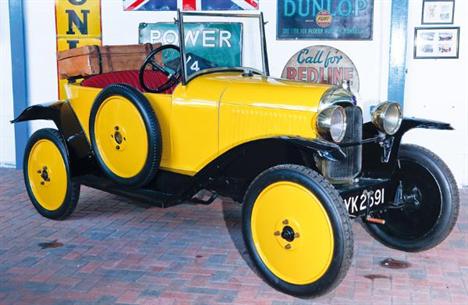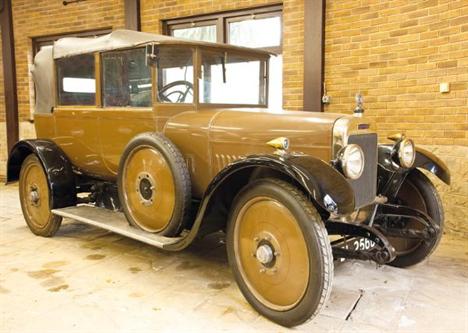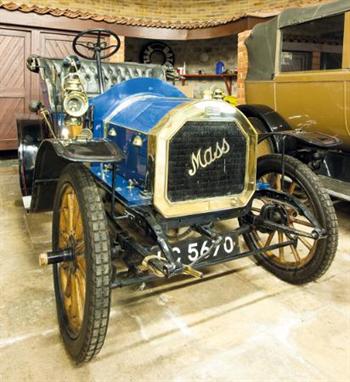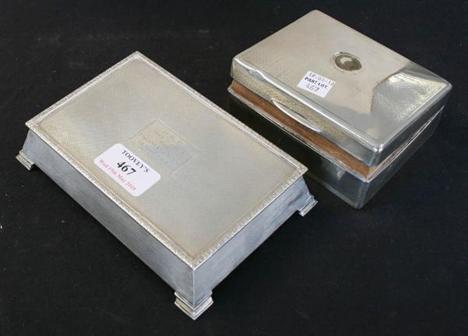1914 CADILLAC FOUR 50HP TOURERRegistration Number: DS 8446Chassis Number: A2238Engine Number: A2238 Marketed as `The Standard of the World`, the Cadillac Four, a powerful 6 litre, four cylinder Tourer, was possibly the most sophisticated American motor car of 1914. The company produced the model with such modern innovations as electric starting and lighting, and a unique electric two-speed rear axle, which effectively produced six forward speeds, together with automatic ignition advance and retard, an electrically heated carburettor and a practical fold-away steering wheel.This example was part of the well-known Clive Unsworth collection. The Cadillac is finished in black with matching buttoned upholstery and is equipped with its original brass headlamps, nickel electric side lamps and detachable wheel rims with varnished wooden spokes.The file includes correspondence, invoices, old MOT test certificates, a copy manual of care and operation, an original manual and the V5C registration certificate.Careful recommissioning may be appropriate following museum storage. See illustration (FP)
186062 Preisdatenbank Los(e) gefunden, die Ihrer Suche entsprechen
186062 Lose gefunden, die zu Ihrer Suche passen. Abonnieren Sie die Preisdatenbank, um sofortigen Zugriff auf alle Dienstleistungen der Preisdatenbank zu haben.
Preisdatenbank abonnieren- Liste
- Galerie
-
186062 Los(e)/Seite
1925 CITROEN TYPE C `CLOVERLEAF` TOURERRegistration Number: YK 2591Chassis Number: 47120Citroen first introduced the Type C in 1922. It became a popular choice, due to its practical design and longevity - the Citroen was powered by a four cylinder 856cc sidevalve engine, which was not renowned for speed.... The motor car acquired various names during the few years that it was produced: `Petit Citron` referred to the fact that at the start of production, the Type C was only available in yellow; `5CV` was due to its French tax rating, and the anglicised `Cloverleaf` pointed to its two-plus-one seating. The model was also the first to be built at Citroen`s first foreign factory, at Slough, which opened in 1926.This right hand drive example was purchased new from the Citroen Vehicle Emporium, Turnham Green, West London. The motor car has been the subject of an older restoration, including a repaint and retrim. The cylinder head gasket was also renewed, the carburettor overhauled and the magneto replaced by a coil ignition. The Type C is supplied with the original registration book and the V5C registration certificate.Careful recommissioning may be appropriate following museum storage. See illustration (FP)
1937 ROLLS-ROYCE 25/30 ABBOTT LIMOUSINERegistration Number: BOU 616Chassis Number: GWN 33Engine Number: R123NThe publicity claimed Rolls-Royce to be `The Best Car in the World`, and certainly, they did produce some fine motor cars. Royce built his first model in 1904. He merged with C S Rolls in 1906, and following a successful period of manufacturing, the company then bought Bentley in 1931. The Rolls - Bentley era produced some of Britain`s most magnificent motor cars, being superbly made and proportioned.This handsome 25/30 example was supplied new on the 16th December 1936 to the Hon. Geoffrey Parsons, son of the fourth Earl of Rosse, chairman of Parsons Steam Turbine Company Ltd. Its subsequent history is not recorded, but it has been in the present ownership for a number of years and has been the subject of some restoration. The coachwork, with its practical rear luggage trunk, is smartly liveried in blue over cream and the rear compartment has been re-upholstered in grey cloth and features forward facing occasional seats.The motor car is supplied with a number of MOT test certificates and the V5C registration certificate. Careful recommissioning may be appropriate following museum storage. See illustration (FP and detail of interior)
1930 DENNIS 30CWT DROP-SIDE LORRYRegistration Number: RV 6000Chassis Number: 53161Dennis brothers Limited was founded by brothers John and Raymond in 1895, who began by producing bicycles which they sold in their Guildford shop. Their first proper motor car appeared in 1901, powered by a De Dion engine, swiftly followed by their first bus in 1903 and fire engine in 1908. Manufacturing of commercial vehicles took precedence, and it is likely that motor car production ceased after 1915. Introduced in 1925, the 30cwt became one of the company`s most successful models. Dennis`s own four cylinder engine powered the commercial, and in 1927, the model was upgraded to a four wheel braking system and four speed gearbox, producing a practical and popular vehicle. This fine example was restored by Mr K Brunt of Chertsey during the 1980`s. The current custodian purchased the Lorry at a Bonhams auction sale in 2008. Careful recommissioning may be appropriate following museum storage. See illustration (HP)
1911 BUICK MODEL 39 TOURERRegistration Number: DS 8614Chassis Number: 91Engine Number: 93David Dunbar Buick was a Scottish industrialist but an unlikely motor manufacturer. He made his mark by inventing a process to anneal porcelain to steel in the production of bathtubs. He then invested his profits into the horseless carriage and in 1903, his first motor car was produced. This first model was a simple small chain driven runabout with flat-twin power and featured over-head valves - a rarity at that time which was to become the Buick hallmark from there on. In 1904, Buick moved from Detroit to Flint, Michigan, where it came under the control of William Durant. In 1908, Durant formed General Motors, with Buick as the foundation company. Six cylinders arrived in 1914 and were the only type offered by Buick until 1930.This fine restored Model 39 Tourer features four doors, seating for five people, wooden artillery type wheels, rear wheel brakes, a steel plate clutch (which runs in oil) and a powerful four cylinder 5.2 litre engine. The file includes the V5 registration document, important technical data, photographs in a bound book, copies of Buick history, a copy parts list and information book, and Buick models data. Careful recommissioning may be appropriate following museum storage. See illustration (FP)
1922 ARROL-JOHNSTON 15.9HP `THE ONE DOOR` TOURERRegistration Number: DL 2560Chassis Number: 3701Arrol-Johnston, one of Scotland`s early motor manufacturers, often produced unconventional models. The first came in the successful form of the Model 10 Dogcart in 1898, which was equipped with an opposed-piston, flat-twin 10 horse power engine. Several models then followed, with four cylinder and 23 horse power, six cylinder engines.This rare `One Door` Tourer was based at Penman Engineering, Coachbuilders of Dumfries, who restored DL 2560 for the Dumfries Octo-centenary celebrations in 1986; the Penman Works were in fact just half a mile away from the original Arrol-Johnston factory at Heathhall. The motor car has also been part of the Sword Collection and in the early Nineties, it was purchased by a Mr Bob Dixon. We understand that while in the care of the Penman`s, the Arrol-Johnston was used and rallied by the works supervisor, Mr Ian Gray, who estimated the top speed of about 38mph from the 2613cc engine. This important Scottish vintage motor is supplied with the V5C registration certificate and publications with references to the car. Careful recommissioning may be appropriate following museum storage. See illustration (FP and detail of interior)
1906 DELAGE TYPE F3 6 ½ HP TWO SEATER VOITURETTERegistration Number: UnregisteredChassis Number: 349Engine Number: 22529Louis Delage manufactured motor cars at his Courbevoie-sur-Seine factory from 1905, where he built his De Dion Bouton powered, lightweight Voiturette. Having been formally employed by Peugeot and Turgan-Foy, he recognised the role of motor racing in raising his own company`s profile, and thus successfully entered his popular Delage Voiturettes into many competitions, securing his prominence in pre and post Great War years. In England, the early 6 ½ hp models were marketed in London under the name Friswell. Early single cylinder examples are extremely rare. This Type F3 is an attractive model, having been the subject of an older restoration. It is a racing Voiturette, with individual buckets seats, no mudguards, P&H acetylene side lamps, and is finished in French Racing Blue. The upholstery is in buttoned back black leather.With its engine driving through a cone clutch and three speed gearbox, this Delage certainly has the potential to successfully compete in Veteran Car Club rallies.Documentation included in the file should assist in obtaining a suitable replacement registration number. Careful re-commissioning may be appropriate following museum storage. See illustration (FP and detail of engine)
1927 WINDSOR 10.4HP 2 SEATER WITH DICKEYRegistration Number: KA 6696Chassis Number: X-813Engine Number: 1101The sales brochure of the Windsor 10.4hp, manufactured by James Bartle & Co Ltd of Lancaster Road, London, stated that the car was designed to `meet the demand of the motoring connoisseur`. It was a quality produced motor car, built to a high standard, but sold at a moderate price and economical to run.This rare example, believed to be one of just three in existence, was purchased by Mr George Milligan in 1996 when he was almost ninety years old. He then set about restoring the Windsor, which he completed in six months, at an enormous cost and to an excellent standard. The car was purchased from the late George E Milligan collection at the 2004 Bonhams Goodwood sale and then displayed in the Brading Museum.The engine compartment reveals engineering at its best; an overhead valve engine with a four speed gearbox, all finished to an exacting specification.The history file includes correspondence, invoices, DVLA copies of registration books, photocopies of factory sales literature, an instruction book, road test reports, a vehicle survey report dated 22.11.1996, the V5C registration certificate and an original Windsor Cars sales brochure. Careful recommissioning may be appropriate following museum storage. See illustration and detail of engine
1952 BRISTOL 401 SPORTS SALOONRegistration Number: 112 UXHChassis Number: 401/1155The Bristol Aeroplane Company began to manufacture motor cars in 1947 with an anglicised version of the pre-war BMW 327. Bristol Cars was formed in 1960 and is one of the few British car makers still in existence today. The first model, the `400`, looked very much like a BMW - which really it was: a hand-made BMW based saloon with wind tunnel derived aerodynamics. Then followed the `401`; this model had a body made by Touring of Italy, which consisted of alloy panels over a steel tube frame, powered by a six cylinder 1971cc OHV engine. These same units were used by Cooper, Frazer Nash and AC, and were also based on the pre-war BMW units.We understand that this example has been in the care of four previous custodians and is supplied with the V5C registration certificate, the old V5 document, several past MOT test certificates, invoices and an original 403 instruction manual.Careful recommissioning may be appropriate following museum storage. See illustration (HP) and detail of interior
1913 CLEMENT BAYARD TYPE CB1 12HP TOURERRegistration Number: UnregisteredChassis Number: 19535Engine Number: 1953As with many car manufacturers, Adolphe Clement began his automotive career by producing bicycles. His early cars were powered by the De Dion Bouton engine. In 1913, four models were produced, ranging from 8 to 14hp, all powered by four cylinder monobloc engines. Clement Bayard was sold to Andre Citroen in 1922.This 12hp, right hand drive, four seater example was part of a collection at Aalholm in Denmark and then sold in 1994. Since that time, the car has also been exhibited at the Dutch National Motor Museum.The distinctive motor car has a three speed gearbox and is furnished with brass fittings, including a double twist bulb horn, Ducellier acetylene headlamps (powered by a running board mounted generator), and Phares Besnard oil side lamps. Documentation included in the file should assist in obtaining a suitable replacement registration number. Careful recommissioning may be appropriate following museum storage. See illustration (FP)
1913 SWIFT 7HP TWIN-CYLINDER TWO-SEATER CYCLECARRegistration Number: FP 372Chassis Number: C368Engine Number: E2133Writing in 1911, `Kuklos` (or W Fitzwater Wray), the cycling and motoring correspondent of the Daily News, said of the single cylinder Swift: " The Swift Motor Co Ltd can honestly claim to have been the pioneers in this country of the small car movement….. Their 7hp two seater is a beautiful example of the best work of the modern locomotive engineer, and there are few such clean and thoughtful specimens of his work as the power unit of this muscular motorkin".The single cylinder 7hp car was replaced for the 1912 season by the twin cylinder Swift Cyclecar, which was exhibited at the Olympia Cycle and Motor Cycle Show that year. Powered by a 972cc engine, the new Swift sported more modern advances such as thermo-syphon cooling, magneto ignition, leather-to-metal clutch, three forward and reverse speeds and a live rear axle.This example was first registered in Rutland in 1913. The motor car has been museum displayed for some forty years, having been acquired by a collector in 1969, and again by its current custodian in 2004.This attractive light Edwardian, eligible for the prestigious Veteran Car Club `Singles and Twins` events, is finished in green with black wings, wire wheels and brown leather upholstery. The car is equipped with brass acetylene headlamps, a double twist bulb horn, a folding brass windscreen and a Stewart speedometer. It is supplied with a Veteran Car Club Dating Plate and rally plaques, which confirm activity in the VCC from 1958 - 1961.Documentation included in the file should assist in obtaining a suitable replacement registration number or the original. Careful recommissioning may be appropriate following museum storage. See illustration (HP)
C1934 SINGER NINE SPORTS 4 SEATERRegistration Number: BHP 83Chassis Number: TBASinger was one of the many British companies that originally produced bicycles. The Coventry factory made a three cylinder motor car under licence from Lea-Francis in 1905, and in 1906, the first genuine Singer arrived. Early cars had two, three and four cylinder engines; at the lower end of the range was the 1100cc Ten, and at the top was the 25hp, four litre model. Post war, only smaller engines were produced, including the development of the well-known Junior and Senior models. In 1932, the Nine Saloon came into being, together with the famous Le Mans sports cars, which used the overhead camshaft engine design.It is understood that this pretty four seater Nine Sports version, was resident on the Isle of Wight from the late 1950`s. Its then custodian was an aircraft engineer who, we are told, used the Singer in his courting days; during which time, he learnt about motor cars - and many other things besides! Some time later it was acquired by the Isle of Wight Nissan dealer Dave Perkis, who carried out a complete restoration on the motor car. In 2000, the Singer was purchased for display in the Brading Museum.Careful recommissioning may be appropriate following museum storage. See illustration (HP)
1910 ARMSTRONG-WHITWORTH 18/22 HP THREE-QUARTER LANDAULETTE WITH COACHWORK BY MAYTHORNRegistration Number: CD4627Chassis Number: 227Engine Number: 22-090Before the First World War, sixteen different models of the Armstrong-Whitworth were produced from the Newcastle-Upon-Tyne factory. Early models were the 28/36 of 1907, followed by 30 and 40 horse-power versions. The company then produced a range of medium sized motor cars, but prior to the war, reverted back to manufacturing some extremely large vehicles, such as the 30/50. Post-war, Armstrong-Whitworth ceased to manufacture further models. The descendant of the marque was Armstrong-Siddeley.It is understood that this elegant, Brighton registered, Three-Quarter Landaulette, with Maythorn of Biggleswade coachwork, carried out duties as a hire car at Brighton Station. In 1965, the motor car was purchased by Mr George Milligen from the Sword Sale for £1280. Restoration commenced in 1985. The engine was rebuilt by Arthur Archer; works included fitting separate-cast cylinders and increasing the bore sizes from 95mm to 102mm, producing a swept volume of 3.9 litres. The current custodian purchased the Edwardian from the late George E Milligen Collection at the Bonhams Goodwood sale in 2004.The V5C registration document is supplied with the motor car, together with a detailed drawing of the engine repair, correspondence, photographs, invoices and other documents. Careful recommissioning may be appropriate following museum storage. See illustration (FP)
1914 RENAULT EK 9HP TWO SEATER WITH DICKEYRegistration Number: UnregisteredChassis Number: 43060Engine Number: 6215Arriving in 1905, the Renault AX was a motor car of simple design. Powered by a twin cylinder engine driven through a three speed gearbox, the Renault was simple, robust and easy to drive. The EK followed, retaining the popular simplicity, but with a little more power.This charming Edwardian is appointed with acetylene headlamps and Willocq & Bottin oil side lamps, powered by a running board mounted acetylene generator, together with a double twist bulb horn, a folding one piece windscreen, a hand-operated windscreen wiper, a Stepney wheel and a `park bench` two-seat Dickey. The twin cylinder engine is fitted with a later magneto and Lavalette magneto. The supplier`s plate states that the motor car was supplied by Christy & Medeces of Avenue Saxe of Lyon; the original coachwork is by Lafond & Nicholas.The file contains photographs recording the Renault`s discovery and acquisition as one of the first cars of the Lips Collection. Further documentation included in the file should assist in obtaining a suitable replacement registration number.Careful recommissioning may be appropriate following museum storage. See illustration and detail (FP)
1905 MASS 8HP TWO SEATERRegistration Number: LC 5670Engine Number: 18097Mass motor cars were built in Courbevoie, Seine, for the English market and took their name from their importer, Mr Masser-Horniman. From 1912, it was sold in its homeland under the name of its manufacturer, Pierron. Initially, there were only single cylinder versions of the 4 ½ hp and 6hp models, but in 1905, two and four cylinder versions arrived. From 1907 and up until the Great War, the range became more advanced.This example was found in the 1950`s by John Jarvis, having been left in a garage in Highgate by its then owner since before the First World War. Since its rediscovery, the Mass has been part of the collection of the late John Ahern. Correspondence in the history file confirms that it was also part of the Patrick Collection up until 1996.Now in restored condition, this attractive Edwardian motor is finished in blue with black wings has black leather upholstery and is complete with a beige double duck hood, brass radiator, rear mounted spar and side lighting. It is thought to be the sole surviving example of the marque.The aforementioned vast history file includes important data and history notes, photographs, the V5C registration certificate, and a VCC Dating Certificate No. 652, dated 12th June 1957. Careful recommissioning may be appropriate following museum storage. See illustration
1913 MITCHELL TOURERRegistration Number: AY 2838Chassis Number: 31286Engine Number: 31454The Mitchell Company was initially known as the Wisconsin Wheel Works. Bicycle production advanced into a 1.75hp motorcycle in 1901 and experimental motor cars followed in 1903. With the new product, the company changed its name to the Mitchell Motor Car Company in 1904. These early models were twin-cylinder, chain driven runabouts; four-cylinder, shaft driven, water-cooled models then followed.We understand that this beautifully restored example was owned by a Royal Flying Corps Officer, understood to be Alistair Miller, who used it as his personal transport in 1915/16. This is recorded in a letter (in the history file) dated 10.10.1979, from Mr W Boddy, the then editor of the Motor Sport magazine.The history file also includes a copy of the VCC Certificate of Dating, dated 5.5.1976, together with the V5C registration certificate, correspondence, photographs of the car prior to the restoration and details of the restoration process, and a 1913 Mitchell Motor Cars sales brochure copy. A car sale invoice dated 18.5.1994 is also included, showing the cost of the Mitchell as £25,000.This powerful 6 ½ Litre Edwardian motor car is equipped with electric lights and starter. Careful recommissioning may be appropriate following museum storage. See illustration
A George V silver and tortoiseshell circular jewellery box, piqué inlaid with flowers and ribbon, on cabriole legs, Birmingham 1926, a silver cigarette box with engine turned decoration Birmingham 1938, a hobnail cut perfume bottle with embossed silver hinged lid, a dressing table jar, shoe horn, button hook, a pair of silver circular dishes, a plated three piece tea set and a pair of plated sugar tongs.
A silver and pink enamelled circular lady`s powder compact, with engine turned decoration, Birmingham 1951, a silver circular lady`s powder compact, initialled `B`, with engine turned decoration, Birmingham 1950, and a Stratton gilt metal circular powder compact, the cover decorated with a palmette motif, with the original slip case.
A small silver cased key wound half hunter pocket watch with engine turned decoration, blue enamel Roman numerals to the case and the plain white enamel dial with Roman numerals and separate seconds dial (working order) and a gentleman`s silver cased key wound pocket watch, the plain case with engraved cartouches to front and back and the plain white dial with Roman and Arabic numerals and separate seconds hands marked W R Thompson, Liverpool (as viewed, front glass missing).
Antique oval locket, approx. 40mm x 28mm, engine turned pattern to both sides, stamped 9ct back & front, complete with17 fancy link base metal chain, fitted with barrel fastener, small ornate fob seal set with multi-coloured agate, stone very slightly scuffed,& a gold faced `Baby` brooch, approx. 30mm (3)
Ladies` `Waltham` pocket watch, top wind, working order, white dial, approx. 28mm, black Roman numerals, gold plated case with ornate monogram on back & a gent`s `Waltham` pocket watch, top wind, working order, white dial, approx. 45mm, seconds dial & black Roman numerals, gold plated case with engine turned pattern to back with shield in garter cartouche to centre (2)
Misc. 9ct back & front lockets (3), oval, approx. 25mm x 30mm, pattern to both sides, to hold four photographs, oval, approx. 18mm x 22mm, pattern to both sides, to hold two photographs, circular, approx. 25mm, engine turned pattern around rim of front, plain back, very slight dents to back & a cigar cutter, approx. 42mm, white metal, handle clad in ornately patterned & stamped 9ct gold (4)
-
186062 Los(e)/Seite












































